This report covers:
- Three pellets
- The test
- Testbed
- Regular Baracudas with 5.53mm heads
- On to the new pellets
- Baracuda 18
- Baracuda 15
- Not a complete test
- All sold out
- Summary
Today we have our first look at the new Baracuda 15, plus we compare accuracy between the regular 21.14-grain Baracuda, the new Baracuda 18 and the newer Baracuda 15.
Three pellets
I covered the history of the original Baracuda pellet in Part One of this series. Let’s look at the two new pellets.

From the left we have the original Baracuda pellet upright and lying down. Then comes the Baracuda 18 and the Baracuda 15. Looking inside the skirts you can see where the weight is and isn’t.
The new pellet comes in head sizes and I happened to get two tins of 5.52mm heads. My Baracuda 18s are also 5.52mm. My regular Baracudas are 5.53mm. This would be a better test is all three were the same head size, but these days you’re just lucky to get pellets at all.
The test
I plan to shoot all three pellets from different pellet rifles at different distances. That should give us a little insight into how gun-specific they are. But I won’t do all of that today.
Today’s test will be short, with one 10-shot group from each pellet. I’m shooting with a rested airgun at 25 yards.
Testbed
Today I chose to shoot my Air Arms S510 XS. I don’t get to shoot it often, so I relish any chance I get. From past testing we know that this rifle produces around 25-33 foot-pounds, depending on the pellet and the power setting. Today I’m shooting it with the power set two clicks down from maximum for all three pellets. That produces good power and also conserves air.
We know from past tests that the rifle is quite accurate with most pellets. And it sports the Meopta MeoPro Optika6 3-18X56 scope that I have reported on in the past. So today’s testbed is a good, accurate pellet rifle with a great scope.
Regular Baracudas with 5.53mm heads
First up were regular 21-grain Baracudas. I knew from past testing that the rifle was on target for 25 yards, so I got right to it. There was no sight-in. Unfortunately the third shot blew away my aim point and the rest of the first group was shot with guesswork. Ten pellets made a 25-yard group that measures 0.486-inches between centers. For many rifles that would be good, but the S510 is capable of better.
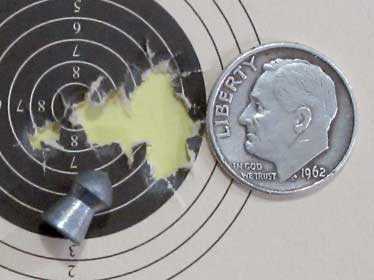
On shot number three I blew away the 10-dot which was my aim point. You can see part of it here but when it’s smaller in the eyepiece and the rifle is moving I couldn’t see it. So all the other shots were guesses where the center of the bull was. Ten shots in 0.486-inches.
I felt that was not a fair test because of the aim point, so I shot a second group. But first I dialed the impact point down 10 clicks, so the center of the bull would be preserved.
The second group of 10 pellets measures 0.431-inches between centers. It’s not that much better than the first group and that means two things. First, I did a good job of guessing where the center of the bull is when shooting the first group and second, this is about as good as this pellet is going to get in this rifle.
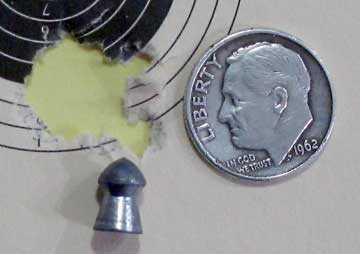
This second group of 10 Baracudas is lower, so the aim point was preserved. This group measures 0.431-inches between centers.
On to the new pellets
Now we move on to the two new pellets. First up is the Baracuda 18. This pellet actually weighs 18.13-grains.
Baracuda 18
The Baracuda 18 with a 5.52mm head went to almost the same place on the target that the heavier Baracuda went. Ten pellets made a group the measures 0.263-inches between centers. Now that is a group! The Baracuda 18 is definitely a good one for the S510 XS rifle.
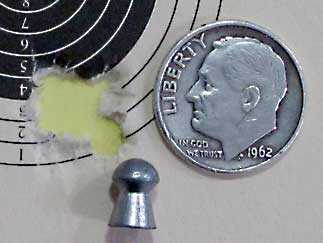
Yes! The Air Arms S510 XS likes Baracuda 18s! Ten pellets in 0.263-inches at 25 yards.
Baracuda 15
Now for the real test. How will this new light Baracuda 15 perform? And by the way, this one weighs 15.89-grains, so it’s almost 16 grains. We know the rifle is an accurate one, so will this new dome prove to be accurate, as well?
Well, it is. Ten pellets went into 0.322-inches at 25 yards. That’s another good group. Apparently we have a new premium pellet that may be in better supply that some pellets on which we have come to rely.
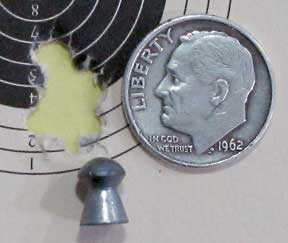
Ten Baracuda 15 pellets went into 0.322-inches at 25 yards. Ladies and gentlemen, we have a winner!
Not a complete test
Folks, this wasn’t a full test of the Baracuda 15. For that we need a lot more groups from a lot of different airguns. This was just the start of all the testing I plan to do.
All sold out
When I wrote this report there were no Baracuda 15s left in stock. But H&N is making more, so watch for them. With the sometimes unstable supply of JSBs that get hygraded over on eBay, these might turn out to be a good backup pellet.
Summary
So far, so good. But I still want to test them in a spring rifle and in a low-powered springer.

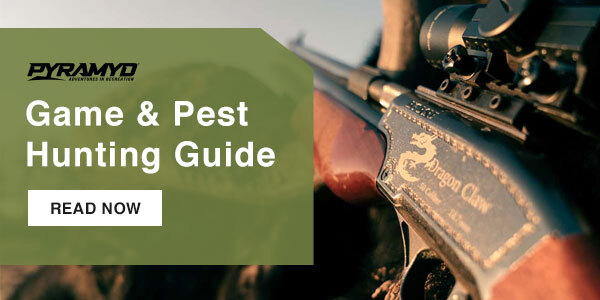
Everyone,
This one was WordPress’s fault. I had to schedule it twice yesterday and apparently it decided to unschedule itself after I logged out.
BB
B.B.
Better late than never…
Is there any “short cut” to determine the best head sized of the best pellet for your airgun? Or do just need to order them all, and shoot them all?
-Y
Yogi,
Shooting them all is the only way I know of to determine the best pellet.
BB
Yogi,
I suppose you could slug the barrel and inspect how smooth and even the engraving of the rifling is. Obviously, you’d want to do it from breech to muzzle, which limits the practicality of this to break barrels and designs that give unobstructed access to the breech.
Nathan
Nathan
Then what after slugging the barrel?
You try the pellet that the rifling goes in deep or goes in lightly. Or maybe the pellet is just right. As in right of the middle of the deep or light engraving of the rifling.
I would say at that point all you can do is shoot those 3 different fit pellets and see what happens.
Or maybe there is a physics formula for that. It might get you close but I bet you still end up shooting and gather the data from the targets.
chanman819,
Nathan it certainly never hurts to know the results of slugging an airgun barrel. The problem with pellets is they may have their skirts deformed (blown out) by the air blast and then the acceleration down the bore is substantially different than pushing it through the bore by hand.
If you are shooting bullets (slugs) then knowing the bore dimensions is far more informative for projectile selection but you still need to shot the ones that FIT the bore correctly based on the information gathered on the bore slugging.
shootski
B.B., what do you mean by “hygraded”?
I happen to have a few of all three pellets. I can shoot them through my R9, which is turning out not to be a picky eater, and compare with your spring rifle results.
Roamin,
First of all, I misspelled it. It’s a hyphenated word high-grade.
verb (used with object), high-grad·ed, high-grad·ing.
to steal (rich ore) from a mine.
In this case it means taking something that sells for X and buying as many as possible so there are none left and you can sell them for 2X.
BB
“Today I’m shooting it with the power set two clicks down from maximum for all three pellets.”
BB,
It would be interesting to note the velocities for each pellet weight. Unfortunate that the head size wasn’t the same for all them as it adds another variable.
By your testing, the current settings and the harmonics of the S510 favors the 18 grain Baracudas but I wonder if adding one click (or two) more power would favor the 21 grain or going one click less would better suit the 15 grain pellets.
I suggest this because of my experiences with my Impact MK2. In testing 13, 16, 18 & 25 grain JSBs I have seen a tune (clearly) favor one weight and then by making an adjustment change the “golden pellet” to a different one. In playing around with the settings I can tune the gun to shoot any (consistent) pellet well. Currently I’m tuned to Crosman HP pellets (I found a large stock of them at a local hardware store 🙂 ) and if I weight-sort them I get good groups.
As you mentioned, the H&N would be a good alternate to the JSBs. Testing different weights in an airgun is interesting, IMHO, testing the two brands against each other would be even more so. Ideally, we would be lucky and the H&N and JSBs would have the same POI and similar group size.
Hank
Hank,
You always come up with the most interesting things! And if I did test them against each other, who is to say IO didn’t test each one to the best of its ability?
You see, I am chewing on your “choosing the best caliber” blog right now.
BB
BB,
I trust that you wouldn’t play favorites 🙂
Besides, your shooting on an “off” day is probably a lot better than I can do on a “good” day LOL!
Hank,
Right now I am editing the “new pellet trap” guest blog for tomorrow.
BB
Gonna be sure to read it; with the excellent mulch trap performance, whatever could this one be about? 🙂
And how does it handle 22LR?
Mister AP,
Hank will have to address that one.
BB
BB,
Hope there’s very little editing required! I do guest blogs to save you work – not make more work. LOL!
Please let me know if I need to change my template!
Hank
Hank,
Compared to some there is very little editing required. 😉
BB
BB
Thank goodness.
Time to save the old choppers then and stop chewing at it for another one of those best caliber reports.
A simple link to those blogs could be a report in its self.
BB and Hank.
Please not another best caliber blog tomorrow.
When I came home from work this morning I had a starling invasion. Needless to say I used all 3 small bore calibers.
.177 Gauntlet gen1, .22 caliber Semi Auto Marauder (SAM) and .25 caliber Condor SS.
I got 6 birds with the .177 caliber gun and 5 with the. 22 caliber SAM. And 5 with the. 25 caliber Condor SS. I shot 10 shots with each caliber and shots were from 70 to 90 yards with each caliber. I was aiming at a paticular bird out on the edge of the mass of birds in the field. I had the different guns rested on my shooting bag on the trunk of the car in the driveway. To note it was a very stable, comfortable rest position.
So somebody has to be thinking how did I take so many shots and got so many birds. First when the birds are on thier 1000 bird rampage they are stupid. They don’t
even know your there. They go crazy. Next all 3 air guns I used are very quiet.
So it will be interesting to see what the best caliber is tomorrow and what that is based on.
GF1,
There ain’t a’gonna be a “best caliber” report tomorrow. I am chewing on it, which means I’m trying to figure out what I haven’t already said in the dozen or so reports on that topic, that I have alrerady written.
BB
FWIIW-The best 100 Yard benchrest shooter at my range starts by setting his regulator so he shoots pellets at 940 fps. He then shoot groups. He resets his regulator to 920 fps, he then shoots groups. Repeats until he is at 800 fps.
This is with an internal regulator, an external regulator, and all that other PCP jazz….
-Y
Is he doing it only when testing pellets?
Yes, which he does often. Slugs too, he is shooting .25 caliber.
-Y
Yogi,
For every airgun and pellet there is an optimal tune. The basic considerations are pellet weight, barrel volume (caliber and length) transfer port and the power plant output (volume and pressure).
In a springer, the pellet is only variable to be chosen – unless you are willing to start modifying parts.
With a PCP you can change the variables so they best suit a particular pellet.
The guy at your range is going through a typical tuning process. Choose a pellet, guesstimate the regulator pressure and balance the hammer spring force (some PCPs also have transfer port and valve timing adjustments).
I will try different settings until I am happy with the consistency – for me that’s 1/4 to 3/8 inch 5 shot groups at 40 yards.
I enjoy the process, it’s always satisfying when you get all in harmony. Fun stuff!
Hank
You forgot barrel swap!!! lol
-Y
🙂
BB,
Nice shooting. I have managed to survive without having to buy pellets,… but that also means I don’t get to try the new stuff. Hank brought up a lot of food for thought with his Impact MK2 experiments. Choices are good regardless,… especially when it actually means something,.. and is not just marketing fluff.
Be well all,………. Chris
How you feeling today Chris?
MIsterAP,
That is a question with many answers. Let’s just say,… well enough and call it good. 🙂
Chris
Chris USA,
“Well enough…”
Is good news!
Wishing you the very best.
shootski
I hear ya. Good to see you here again.
Chris,
It’s always good to hear from you.
I have been trying to stay on top of the new pellets ever since the JSB Monster Redesigned pellet showed me what was happening in the world.
We have a guest blog from Hank tomorrow and it looks like a good one!
BB
Chris
And you know why that is. You already know what the best pellets are.
Back when you and I tried different pellets we researched and then got the pellets and tried them in our paticular guns. We first hand exsperianced what they did in our guns.
How else would you do it. Just because somebody say’s something works it ain’t nothing like exsperiance.
Question about lubing seals. For example: a Discovery or a Marauder, we can put Chamber oil on the Foster fitting to get blown into the gun. On a Crosman 2240 and other CO2 guns, put Pellgunoil on the CO2 Cartridge.
So now what about the bottle guns for example the Ganutlet. If you put chamber oil on the Foster fitting, it goes into the air tank. Does it then get blown into the gun to lube the seals?
Jonah,
Some oil probably gets into the gun. As far as I know that is the best way to do it without disassembly.
BB
Jonah,
I put a small drop on the fill port of all my PCPs (air tube or bottle) and have disassembled many different types over my decades on the Dark Side. It works! Like most things a little goes a long way. I don’t do it every fill maybe once every 20 fills.
Be advised I only use Dive Shop Air so someone who uses a hand pump or a compressor without a drying system needs to talk to that wet air experience.
shootski
Shootski
One drop air chamber lube in gun’s reservoir port every time or every 20th time PCP is filled?
Deck
Decksniper,
I do it every 20th or so fill.
Remember I shoot mostly air hogs so someone shooting an air sipper might do it even less and still get good results.
I REALLY do believe that LESS is MORE when it comes to lubrication.
Well unless we are talking Stoner actions AR10 & AR15 then I run it wet unless I’m at Peter Sinks, Utah (coldest place in the lower 48), above the Arctic Circle, or below the Antarctic circle.
shootski
Shootski
Thanks, I will be backing off.
Hoping BB will do another report on lubes.
Deck
Decksniper,
I use the chamber oil mostly to coat the airgun’s metal insides that you can’t wipe down as you can the outsides. Only a few of the O-Rings in a PCP deal with much friction.
I guess as long as it isn’t running out of the breech, the muzzle, or you hear sloshing sounds from the air cylinder you haven’t used too much chamber oil.
I have a huge supply of all kinds of O-Rings and the most used are those on the bolt probes on my Crosman/Benjamins!
shootski
Shootski and BB
My intent is to avoid having to fool with moisture control products. I was thinking a drop or two of chamber oil in the fill probe would prevent any water from damaging the PCP internals sort of the way Pellgun oil is used on CO2 and single stroke pneumatics.
Deck
Deck,
I have found water inside PVP reservoirs but never any rust. The oil coats the inside wall of the reservoirs that I have seen and the water gets blown out. Dennis Quackenbush and I proved that years ago with an experiment on one of his big bores.
BB